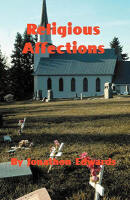 Religious Affections by Jonathan Edwards is a masterpiece. Jonathan Edwards is the greatest theologian America has ever known, and this book is a testimony to that fact. Following the Second Great Awakening many people abandoned the Christian faith which they embraced during the revivals. Many people who appeared to be genuinely converted reverted to their previous worldly lifestyle and many were even worse than before the revivals began. This begs the question, how can we know for certain whether someone has truly been converted to Christianity? Edward's short answer is that true religious affections consists primarily in Christian practice that endures, and there is no way to determine whether someone is a true believer otherwise. Nevertheless, it is still extremely valuable to know with relatively certainty who is a false convert, for the betterment of the Church, and the help of the Church leaders.
Religious Affections by Jonathan Edwards is a masterpiece. Jonathan Edwards is the greatest theologian America has ever known, and this book is a testimony to that fact. Following the Second Great Awakening many people abandoned the Christian faith which they embraced during the revivals. Many people who appeared to be genuinely converted reverted to their previous worldly lifestyle and many were even worse than before the revivals began. This begs the question, how can we know for certain whether someone has truly been converted to Christianity? Edward's short answer is that true religious affections consists primarily in Christian practice that endures, and there is no way to determine whether someone is a true believer otherwise. Nevertheless, it is still extremely valuable to know with relatively certainty who is a false convert, for the betterment of the Church, and the help of the Church leaders.
Religious Affections begins by listing examples of false signs of religious affections, and lists several examples people use to determine whether someone has been converted that are incorrect. Often Edwards considers Balaam, Saul, and Judas as examples of false converts. Edwards determines twelve criteria to help us recognize a true convert to Christianity. It is still possible, to fully exhibit all twelve of these characteristics and still fall away from the faith. Finally, Edwards answers all the objections and exceptions to his twelve attributes.
False Religious Affections
- It is no sign one way or the other, that religious affections are very great, or raised very high.
- It is no sign that affections have the nature of true religion, or that they have not, that they have great effects on the body.
- It is no sign that affections are truly gracious affections, or that they are not, that they cause those who have them to be fluent, fervent, and abundant, in talking of the things of religion.
- It is no sign that affections are gracious, or that they are otherwise, that persons did not make them themselves, or excite them of their own contrivance and by their own strength.
- It is no sign that religious affections are truly holy and spiritual, or that they are not, that they come with texts of Scripture, remarkably brought to the mind.
- It is no evidence that religious affections are saving, or that they are otherwise, that there is an appearance of love in them.
- Persons having religious affections of many kinds, accompanying one another, is not sufficient to determine whether they have any gracious affections or no.
- Nothing can certainly be determined concerning the nature of the affections, by this, that comforts and joys seem to follow awakenings and convictions of conscience, in a certain order.
- It is no certain sign that the religious affections which persons have are such as have in them the nature of true religion, or that they have not, that they dispose persons to spend much time in religion, and to be zealously engaged in the external duties of worship.
- Nothing can be certainly known of the nature of religious affections by this, that they much dispose persons with their mouths to praise and glorify God.
- It is no sign that affections are right, or that they are wrong, that they make persons that have them exceeding confident that what they experience is divine, and that they are in a good estate.
- Nothing can be certainly concluded concerning the nature of religious affections, that any are the subjects of, from this, that the outward manifestations of them, and the relation persons give of them, are very affecting and pleasing to the truly godly, and such as greatly gain their charity, and win their hearts.
True Religious Affections
- Affections that are truly spiritual and gracious, do arise from those influences and operations on the heart, which are spiritual, supernatural and divine.
- The first objective ground of gracious affections, is the transcendently excellent and amiable nature of divine things as they are themselves; and not any conceived relation they bear to self, or self-interest.
- Those affections that are truly holy, are primarily founded on the loveliness of the moral excellency of divine things.
- Gracious affections do arise from the mind's being enlightened, richly and spiritually to understand or apprehend divine things.
- Truly gracious affections are attended with a reasonable and spiritual conviction of the judgment, of the reality and certainty of divine things.
- Gracious affections are attended with evangelical humiliation.
- Another thing, wherein gracious affections are distinguished from others, is, that they are attended with a change of nature.
- Truly gracious affections differ from those affections that are false and delusive, in that they tend to, and are attended with the lamblike, dovelike spirit and temper of Jesus Christ.
- Gracious affections soften the heart, and are attended and followed with a Christian tenderness of spirit.
- Another thing wherein those affections that are truly gracious and holy, differ from those that are false, is beautiful symmetry and proportion.
- Another great and very distinguishing difference between gracious affections and others is, that gracious affections, the higher they are raised, the more is a spiritual appetite and longing of soul after spiritual attainments increased.
- Gracious and holy affections have their exercise and fruit in Christian practice.
I highly recommend this book, but be careful which printed version you buy. This is a 400 page book, and my copy had the entire book compressed into only 200 pages, so it was impossible to read. This book is a difficult read, and if you struggle with heavyweight theology books, I discovered that there is a modern paraphrase of Religious Affections written by Sam Storms, titled Signs of the Spirit: An Interpretation of Jonathan Edwards's "Religious Affections".



Leave a comment